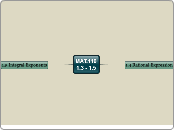MAT.116
1.3 - 1.5
1.4 Rational Expressions
Definition
A rational expression is a quotient of polynomials.That is, it is a ratio (or fraction) of polynomials.The denominator can never be 0.
Simplifying
A rational expression is simplified, or reduced to lowest terms, if its numerator and denominator have no common factors other than 1 (and -1).We can only cancel common factors, we cannot cancel common (or even similar) terms.
1.3 Factoring Polynomials
Factoring
Expressing a polynomial as a product of two (or more) polynomials, each of lesser degree than the original polynomial.A polynomial is completely factored (over the set of integers) if it is expressed as a product of prime polynomials with integral coefficients.NOTE: The text's author has chosen to limit factoring to the set of integers. It is also possible, though considerably more difficult, to factor over the set of rational numbers, or even over the set of real numbers.
Common Factors
The first step whenever factoring a polynomial is to factor out the greatest common factor from all of the terms.
Some Important Formulas
Difference of Two SquaresPefect Square TrinomialIn the text, see Table 7.Don't worry about the cube formulas.
Trial-and-Error Factorization
For quadratic polynomials of the form x^2 + bx + c, where b is not 0, we can factor by finding two factors for c which sum to b.
Leading Coefficient 1
For quadratic polynomials of the form x^2 + bx + c, where b is not 0, we can factor by finding two factors for c which sum to b.
Leading Coefficient Not 1
For quadratic polynomials of the form ax^2 + bx + c, where a and b are not 0, we can factor using a trial-and-error method.First, choose an integer factorization for the leading coefficient a. For example, let pq = a be such a factorization.Then, if our factorization of a is correct, we know that the factored form must look like (px + r)(qx + s), where rs = c. We try different values for r and s to see if we can find a combination, along with p and q, that end up giving b for the coefficient of the middle term.If no such combination of r and s can be found, we choose a different factorization for the leading coefficient a and repeat the process.If, after trying all possible combinations of p and q values with all possible combinations of r and s values a factorization is never found, it can be stated that the polynomial is prime (over the integers).
Factoring by Regrouping
Sometimes when a polynomial has four terms it is possible to factor the terms in pairs and find a common factor to each pair. Then the distributive law can be used to finish the factoring process.
Other Methods
There is a more mechanical method that can be used in place of the trial-and-error method for quadratic polynomials with leading coefficient not 1 and linear coefficient not 0.There are also graphical techniques for finding factorizations. These involve treating the polynomial as a function, graphing it, and looking for the zeros of the function (also known as the x-intercepts or roots).
Operations
Multiplication
This is the same as for fractions: multiply straight across and then simplify the resulting quotient.It is typically easiest to factor the rational expressions before multiplying, and then leave everything factored to help see which factors can be cancelled.
Division
This is the same as for fractions: multiply the first rational expression by the reciprocal of the second and then simplify the resulting quotient.It is typically easiest to factor the rational expressions before multiplying, and then leave everything factored to help see which factors can be cancelled.
Addition
This is the same as for fractions: find a common denominator for the rational expressions, add the numerators (keeping the common denominator), and then simplify the resulting quotient.It is typically easiest to leave the common denominator in factored form to help see which factors can be cancelled after the addition has been performed.
Subtraction
This is the same as for fractions: find a common denominator for the rational expressions, subtract the second numerators from the first (keeping the common denominator), and then simplify the resulting quotient.It is typically easiest to leave the common denominator in factored form to help see which factors can be cancelled after the subtraction has been performed.
Compound Rational Expressions
A compound rational expression is a rational expression that has a rational expression in its numerator and/or denominator.Simplifying a compound rational expression typically requires a combination of the four basic operations plus factoring.It often helps to rewrite compound rational expressions in division form with the division symbol.
1.5 Integral Exponents
Exponential Expressions
If a is a real number and n is a natural number, thena^n = a*a*a* . . . *a.The natural number n is called the exponent (or power) and the real number a is called the base.
Zero Exponent
For any nonzero real number a, a^0=1.0^0 is indeterminate.
Negative Exponents
If a is any nonzero real number and n is a positive integer, thena^(-n) = 1 / a^n
Other Properties
If a and b are nonzero real numbers and m and n are integers, thena^m * a^n = a^(m+n)a^m / a^n = a^(m-n)(a^m)^n = a^(m*n)(ab)^n = a^n * b^n(a/b)^n = a^n / b^n
Simplifying Exponential Expressions
Takes a mix of the stated properties.
